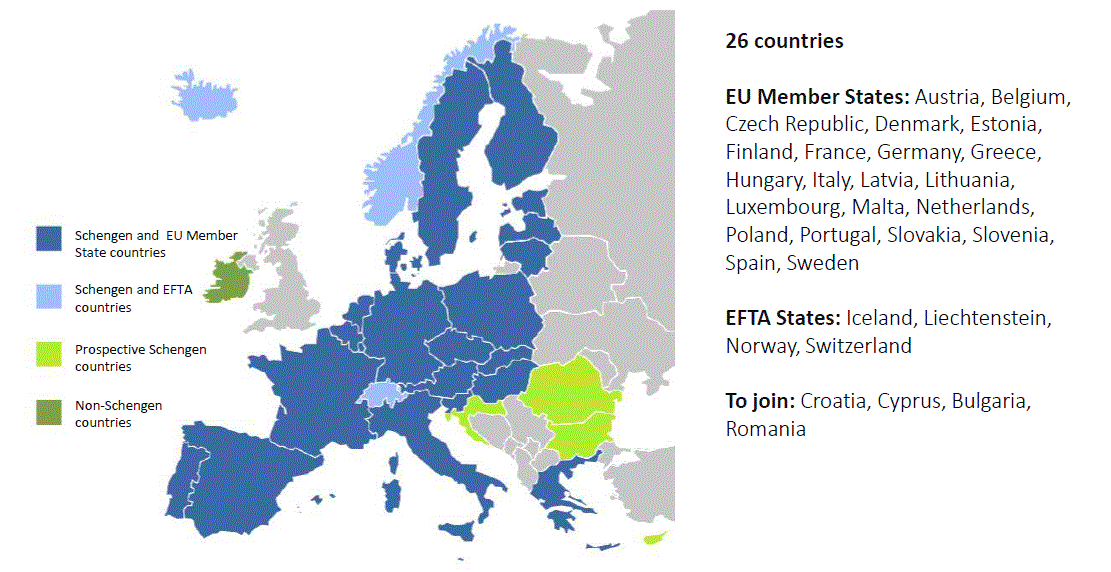
Schengen 2.0
As a result of the migration crisis in 2015 and the terrorist attacks in various European cities in the past few years, the European Commission has proposed various changes to the Schengen information architecture.
(…)
(…)
About Schengen
Cooperation with the EU and EFTA
Efforts to safeguard internal security and manage migration flows have long extended beyond national boundaries. Today, European States need to take a common, consistent approach to such matters. The introduction of Schengen created a joint European area with no internal borders.
Participation in the Dublin System established uniform criteria for examining asylum applications, with each application assigned to just one State.
The basis for Switzerland’s participation in Schengen and Dublin was laid on 26 October 2004 with the signing of the two association agreements. The following year, on 5 June 2005, the Swiss electorate voted in favour of participation. Switzerland’s participation in Schengen and Dublin has been operational since 12 December 2008.
Schengen today
Travel across much of Europe is now largely unrestricted: we can travel from the Mediterranean to beyond the Arctic Circle without passport controls or the need for a visa. This freedom of movement exists because of Schengen. To ensure this mobility securely and legally, freedom to travel within the Schengen Area is accompanied by increased protection of external borders and common provisions on the granting of visas.
Schengen forms a common legal framework that governs the rules for entry/departure and short-term stays in the Schengen area, i.e. the rules on managing the Schengen external borders and on Schengen visas. Citizens from a third (i.e. ‘non-Schengen’) country are subject to the same entry requirements, no matter where they enter the Schengen area, for example by ship in the Netherlands, at an airport in Switzerland, or by train in Poland. The area of Schengen cooperation covers most of the EU Member States and the four associated States (Switzerland, Norway, Iceland and Liechtenstein).
Schengen allowance
The Schengen allowance is maximum 90 days in a 180-day period. The short stay is allowed for Business or Tourism.
Note: UK nationals are now subject to the Schengen allowance, due to Brexit.
By courtesy of Newland Chase, you find here a calculator (Excel file), helping to track days spent in the Schengen Area.

Schengen 2.0
The units responsible for implementing cooperation under the Schengen/Dublin agreements use IT systems that are indispensable for their work. These include the Eurodac and the Visa Information System (VIS) used by SEM in connection with asylum and entry, and the Schengen Information System (SIS) used by fedpol for law enforcement matters.
As a result of the migration crisis in 2015 and the terrorist attacks in various European cities in the past few years, the European Commission has proposed various changes to the Schengen information architecture. The Commission’s legislative initiatives can be divided into three categories:
-
-
- creation of new systems (entry/exit system (EES), European Travel Information and Authorisation System (ETIAS))
- optimisation of existing systems (Visa Information System (VIS), European Dactyloscopy (Eurodac), Schengen Information System (SIS))
- introduction of new components to improve interoperability.
-
These initiatives are intended both to improve the protection of external borders and to increase security within the Schengen area.
EES: Entry/Exit System
The Entry/Exit System (EES) is an information system for managing the external Schengen-borders. The aim of the European Commission’s EES project is to modernize border control, improve security within the Schengen area and increase the efficiency of border checks by automating numerous border control procedures, in order to cope with the continuously increasing number of travelers.
The EES registers all third-country nationals entering and leaving the Schengen area and automatically calculates their duration of stay. It will replace the current manual practice of stamping passports. The EES will facilitate the detection of irregular migration by exposing people who overstay their authorized duration of stay. Additionally, it will help the authorities to carry out checks inside the Schengen area, by identifying people travelling without identity documents with greater accuracy. This is achieved through the use of biometric indicators such as facial images and fingerprints.
When will EES be implemented?
As the implementation has to be orchestrated in all EU countries and Switzerland to go live at the same time, numerous delays already happened. Currently, the expected go-live date is May 2023.
ETIAS: European Travel Information and Authorization System
ETIAS is the new European travel authorization system similar to the US Electronic System for Travel Authorization (ESTA).
Third-country nationals who do not require a visa to enter the Schengen area must apply online for ETIAS travel authorization before travelling to the Schengen area. Authorization costs EUR 7 and is valid for three years.
ETIAS conducts a largely automated risk screening of travellers to ensure greater internal security, prevent illegal immigration and protect public health. Prior risk assessments close existing information and security gaps, thereby increasing the effectiveness of border control. ETIAS travel authorization is a new condition for visa-free third-country nationals entering the Schengen area. Travellers are not automatically granted authorization; without it, they will be refused entry into the Schengen area. Carriers will be required to check that their passengers have valid ETIAS travel authorization at the start of their journey.
ETIAS is designed to enhance internal security while allowing visa-exempt third-country nationals to travel freely.
When will ETIAS be implemented?
Similar to EES, the IT agency of the EU (eu-LISA), together with Swiss implementation team are working on a go-live, which is currently expected not before November 2023.
Picture: Courtesy of Onlinestreet.de

 Seite drucken
Seite drucken